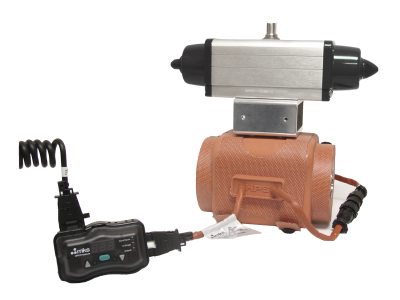Heated Vacuum Isolation Ball Valve
Overview
Heated Vacuum Isolation Ball Valves are designed with a heater specifically made for the ball. These valves have been designed such that the valve body and actuator are separated by an elongated actuator shaft, allowing the entire valve to not only be heated but insulated from heat loss. The unique ball valve heater covers the entire valve body as well as the heatable stainless steel flange clamps on its ends, protecting from heat loss, maximizing the temperature stability inside the valve.
- KF 40 and KF 50
- Designed with straight-through flow paths and less sensitive to contamination
- Designed for heated use up to 150°C
Products
Configuration Options
Please see the Heated Ball Valve datasheet for available product options.
Specifications
-
TypeHeated Ball Valve
-
Helium Leak RateLess than 1 x 10-9 std.cc/sec
-
Body Materials316L stainless steel
-
SealViton® stem seal standard
Other material available -
SeatTeflon® seats standard
Other material available -
Actuator Operating Pressure80-120 psig
-
Maximum Bakeout Temperature150°C
-
Pre-Set Temperature150°C (302°F)
-
Heater Set Points105°C (221°F)
-
Heater Interior RangeAmbient to 150°C (302°F)
-
Heater MaterialsMolded silicone foam, fiberglass reinforced silicone, Teflon insulated wire
-
Heater Exterior RangeAmbient to 70°C (158°F)
-
Heater Foam Thickness0.5 in. (12.7 mm)
-
Heater ComplianceCE, SEMI S2, UL E52951, cUL E5295
-
Heater ConnectorsMolex Mini-Fit Jr.
-
Heater Weight Range0.5 to 6.2 lb (0.73 to 2.8 kg)
-
Connection Ports1.5 or 2.0 inches, depending on configuration
Features
Ball Valve Design
Ball valves are made of a body, stem, ball, and end caps. The ball is sealed within the body by end caps creating a vacuum tight central cavity. The valve is opened and closed by turning the stem 90° back and forth (1/4 turn). The sealing seat for the ball wipes the ball clean as it is opened and closed. This feature provides the ''self-cleaning'' action that makes this valve robust in particle-rich effluent streams. Pneumatic actuators are available.
Ball Valve Heaters
Ball Valves are specifically designed to withstand internal temperatures as high as 150°C to limit contaminant buildup and reduce system maintenance. Ball valves are heated with MKS Series heaters.The heaters’ molded shapes conform to the hardware, minimizing gaps and subsequent heat loss. Using a patented process, silicone foam insulation is bonded to the outside of a reinforced silicone heater mat, resulting in external temperatures that are safe for human contact and meet OSHA safety requirements.
Applications
Ball Valves offer straight-through, unimpeded flow with a minimal valve body footprint. Because of their unique design, ball valves are less sensitive than other vacuum valves to particulate contamination and, therefore, are especially useful in dirty vacuum applications. For example, ball valves are almost always used to isolate scrubbers and traps downstream of the rough pumping system.
Accessories
Resources
Literature
- Heated Ball Valves (306.8 kB, PDF)









 Ultra-High Velocity
Ultra-High Velocity